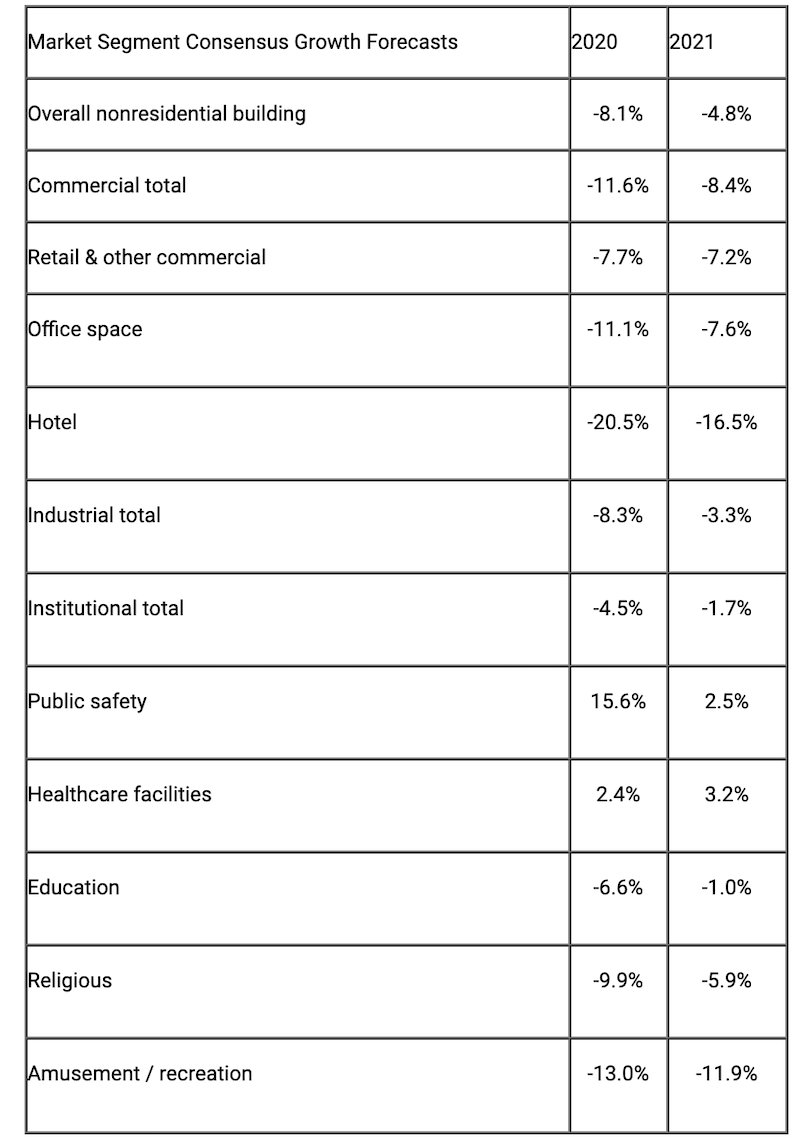As a result of the partially shutdown economy, businesses and organizations will continue to be hesitant to invest in modernized or new facilities, according to a mid-year update to the American Institute of Architects’ (AIA) Consensus Construction Forecast. The trend ends an almost decade-long expansion in construction spending.
The AIA Consensus Construction Forecast Panel—consisting of leading economic forecasters—projects spending on nonresidential facilities will decline just over eight percent this year, and another five percent in 2021. The commercial building sector is expected to be the hardest hit, with spending projected to decline almost 12% this year and another eight percent in 2021. The industrial sector is slated to see declines of five percent this year and three percent next year. While institutional buildings will fare the best on the nonresidential side, spending on these facilities is projected to drop almost five percent this year, and another two percent next.
“As much of the economy was shut down in mid-March to help limit the spread of the pandemic, there was hope that after the initial steep decline in economic activity there could be an almost equally quick recovery,” said AIA Chief Economist Kermit Baker, Hon. AIA, PhD. “However, since mid-June economic growth has stalled. The timing coincides with a spike in new Covid-19 cases across the country, and the resulting pause or roll-back of reopening plans in many states.”
Complete details on the latest Consensus Construction Forecast can be found on AIA’s website.

Related Stories
Market Data | May 2, 2018
Construction employment increases in 245 metro areas between March 2017 & 2018, as trade fights & infrastructure funding shortfalls loom
Houston-The Woodlands-Sugar Land, Texas and Weirton-Steubenville, W.Va.-Ohio experience largest year-over-year gains; Baton Rouge, La. and Auburn-Opelika, Ala. have biggest annual declines.
Market Data | May 2, 2018
Nonresidential Construction down in March, private sector falters, public sector unchanged
February’s spending estimate was revised roughly $10 billion higher.
Market Data | Apr 30, 2018
Outlook mixed for renewable energy installations in Middle East and Africa region
Several major MEA countries are actively supporting the growth of renewable energy.
Market Data | Apr 12, 2018
Construction costs climb in March as wide range of input costs jump
Association officials urge Trump administration, congress to fund infrastructure adequately as better way to stimulate demand than tariffs that impose steep costs on contractors and project owners.
Market Data | Apr 9, 2018
Construction employers add 228,000 jobs over the year despite dip in March
Average hourly earnings increase to $29.43 in construction, topping private sector by nearly 10%; Association officials urge updating and better funding programs to train workers for construction jobs.
Market Data | Apr 4, 2018
Construction employment increases in 257 metro areas between February 2017 & 2018 as construction firms continue to expand amid strong demand
Riverside-San Bernardino-Ontario, Calif. and Merced, Calif. experience largest year-over-year gains; Baton Rouge, La. and Auburn-Opelika, Ala. have biggest annual declines in construction employment.
Market Data | Apr 2, 2018
Construction spending in February inches up from January
Association officials urge federal, state and local officials to work quickly to put recently enacted funding increases to work to improve aging and over-burdened infrastructure, offset public-sector spending drops.
Market Data | Mar 29, 2018
AIA and the University of Minnesota partner to develop Guides for Equitable Practice
The Guides for Equitable Practice will be developed and implemented in three phase.
Market Data | Mar 22, 2018
Architecture billings continue to hold positive in 2018
Billings particularly strong at firms in the West and Midwest regions.
Market Data | Mar 21, 2018
Construction employment increases in 248 metro areas as new metal tariffs threaten future sector job gains
Riverside-San Bernardino-Ontario, Calif., and Merced, Calif., experience largest year-over-year gains; Baton Rouge, La., and Auburn-Opelika, Ala., have biggest annual declines in construction employment.

















